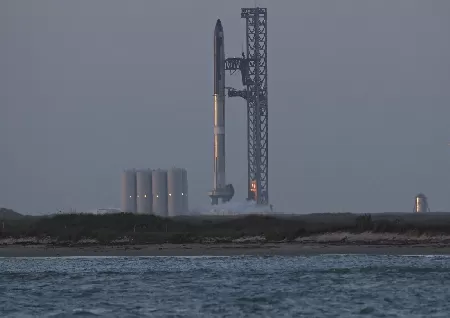Worlds Largest Rocket, Elon Musks Starship, Fails To Take Off

Because of a malfunction with the first-stage booster, SpaceX had to postpone the launch.
It was originally planned for the two-stage rocketship, which is 394 feet (120 metres) tall and taller than the Statue of Liberty, to launch from the SpaceX site in Boca Chica, Texas, during a two-hour launch window that started at 8 a.m. EDT (12:00 GMT).
A pressurisation issue with the lower-stage rocket booster was the reason given by the California-based space business for postponing the flight attempt for at least 48 hours on a live webcast during the last seconds of the countdown.
The mission had a higher probability of not taking off on Monday, according to billionaire business founder and CEO Musk, who spoke to a private Twitter audience on Sunday night.
The launch of the vehicle into space would be a significant step in SpaceX's goal of returning people to the moon and eventually Mars, at least initially as a part of NASA's recently launched Artemis human spaceflight programme.
A successful first flight would also establish the Starship system as the planet's most potent launch mechanism.
Both the upper-stage Starship cruise ship and the lower-stage Super Heavy booster rocket are intended to be reusable parts that can return to Earth for gentle landings, a technique that has proven commonplace for SpaceX's smaller Falcon 9 rocket.
However, neither stage would be retrieved for the brief (less than 90 minutes), disposable first test voyage to space.
The Super Heavy booster has never left the ground, despite five sub-space flights by Starship cruise vessel prototypes up to 6 miles (10 km) above Earth in recent years.
In a test launch of the booster in February, SpaceX ignited 31 of its 33 Raptor engines for nearly 10 seconds, bolting the rocket vertically atop a platform.
Just last Friday, the Federal Aviation Administration approved a licence for the fully stacked rocket system's first test flight, removing the last remaining legal barrier to the eagerly anticipated launch.
The starship will nearly complete a full orbit of the Earth if everything goes according to plan for the upcoming launch attempt. If not, it will re-enter the atmosphere and free-fall into the Pacific at supersonic speed, about 60 miles (97 km) off the coast of the northern Hawaiian Islands.
The Super Heavy rocket is anticipated to carry out the initial stages of a controlled return flight after disengaging from the starship before crashing into the Gulf of Mexico.
As intended, the Starship rocket has roughly twice the power of NASA's own Space Launch System (SLS), which launched a NASA cruise ship dubbed Orion on its first unmanned flight to orbit in November and completed a 10-day trip around the moon and back.
Related queries to this article
- SpaceX
- Starship
- Super Heavy
- launch
- booster
- spaceflight
- reusable rockets
- Artemis program
- NASA
- orbit
- Mars
Read more articles and stories on InstaSity Latest News.





